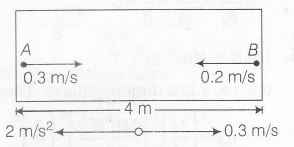Answer:
Option B
Explanation:

Motion of ball A relative to rocket.
Consider motion of two balls with respect to rocket.
Maximum distance of ball A from left wall
$\frac{u^{2}}{2a}=\frac{0.3\times0.3}{2\times2}$
= $\frac{0.09}{4}=0.02m$ (as $0=u^{2}-2as)$
So, collision of two balls will take place very near to left wall

Motion of ball B relative to rocket
For B $S=ut+\frac{1}{2}at^{2}$
$-4=-0.2t-(\frac{1}{2})2t^{2}$
Solving this equation, we get,
t= 1.9 s
Nearest integer =2s